No one has ever seen Dave Love hug a tree, but there’s no doubt that he loves just about anything with a trunk, bark, leaves, cones, needles and/or fronds.
For the past six years, Longwood’s director of landscaping and grounds has kept a watchful, expert eye on the hundreds of trees on Longwood property—protecting, pruning, nourishing and, when necessary, nursing them through disease and other challenges. Once in a while he loses a tree, but he is constantly planting new ones and helping them flourish. In fact, during Love’s tenure, the number of trees on the main campus alone has grown by more than 12 percent. Here’s how he does it.
It’s easy to take trees for granted and think of them as invincible, permanent. How do you view trees?
You have to be really mindful that a tree is a living, breathing structure. They have a life span, they have needs, and they are vulnerable. If we don’t watch out for them, nobody else will. We can do harm to trees without even realizing it.
How many trees are there on the Longwood campus?
In 2011, we had about 580 trees on the main campus. Now we have about 650. This year alone we’ve planted roughly 100 trees. And we have many trees that aren’t on Longwood’s main campus. We have trees at Hull Springs Farm in Westmoreland County and at Lancer Park and Longwood Village. We just planted 16 redbuds in the parking lots at Lancer Park last year, for example.
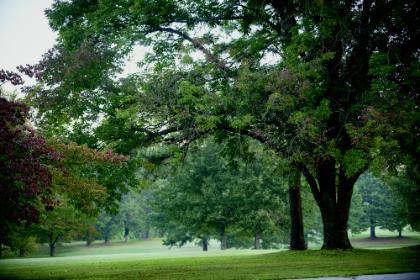
More than 50 species of trees can be found on Longwood property.
What’s involved in planting trees?
A new transplant is very fragile. Right out of the nursery, it’s easy to plant a tree too deep and kill it. The whole root system starts freaking out when it is first planted. Also rain here in Farmville varies during the summer, which is hard on a new transplant. This year we watered our young trees three times a week when it was dry. Each of the 15 staff members in my department plays some role in tree maintenance.
Is there a tree plan?
Yes, as a part of Longwood’s Master Plan, we have a tree-management plan. It outlines what our goals and targets are for tree planting and inventory identification. It includes best practices for planting, pruning and mulching, as well as security practices, norms for calculating tree value and even appropriate signage requirements.
What kinds of trees can be found on campus?
There are at least 50 different species represented on main campus. We have the usual oaks and maples, along with sycamore, locust, dogwood, cherry, linden, buckeye, birch and bald cypress. The real standouts are our Southern magnolia, windmill palms, fig tree, magnolia cucumber and atlas cedar.
How do you keep track of all those trees?
It is difficult, remembering where everything is. That’s why we have a tree inventory. It includes a GPS location for each tree as well as the tree’s common and scientific names. It was started by a student about eight years ago, and we have a student working on it right now to update it.
What is the oldest tree on the main campus?
The catalpa in front of Chichester Science Center is about 100 years old and is probably the oldest tree on the main campus.
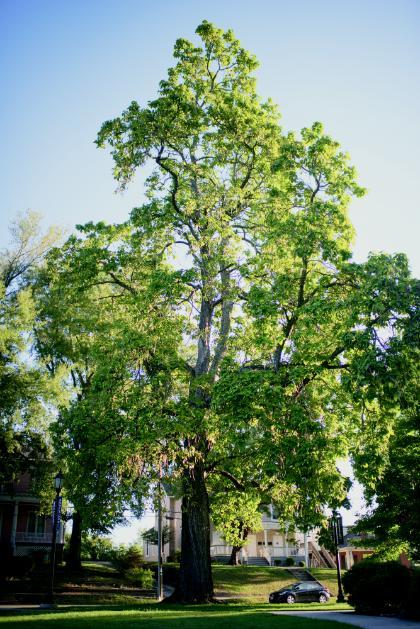
The catalpa tree on High Street in front of Chichester Science Center is about 100 years old.
Are students involved with the management of trees in other ways?
Students, along with faculty and staff, serve on my advisory committee. We talk about new tree planting, trees that might have to be removed, new construction and how to increase our tree population. I also work with the Student Government Association (SGA), I have four to six students who work in Landscape and Grounds as part-time employees, and I have six students who work with me on sustainability as EcoReps. I like to listen to what the students have to say or suggestions about what we can do differently.
Does Longwood do anything special for arbor Day?
We normally plant a few trees each year, but this year the campus really got involved. We had 60 faculty, staff and students turn out on the last Friday in April to plant a total of 16 trees next to the heating plant. The sustainability students and SGA had asked if we could grow some fruit trees, so we planted several dwarf varieties of apple and pear trees that will produce fruit in five to seven years. Actually, one of them produced a couple of apples this year.
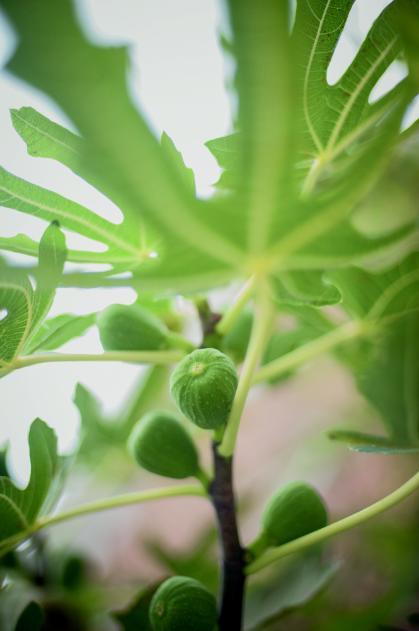
Fall is an exciting time—not just because of the new academic year but because the figs will be ripening. Only a few people know about his little tree, hidden away near the entrance to the Jarman parking lot, but those who do are ready to pounce once the fruit is ready.
Are there any other initiatives brewing?
This December, Longwood will apply for a designation from the Arbor Day Foundation to be recognized as a Tree Campus USA. College campuses must meet five standards to receive this designation, including having an advisory committee, a tree-care plan, a yearly Arbor Day observance, a service learning project and dedicated annual funding for tree care.
What steps do you take to protect Longwood’s trees?
One reason we plant different species of trees and we don’t plant all of them in the same area of campus is to manage the risk to our tree population from disease and environmental factors. We will continue to see insects come Into this country carrying new diseases through imported material—Asia is the source of many newer diseases. Existing trees do not have the immune system to protect themselves from these attacks.
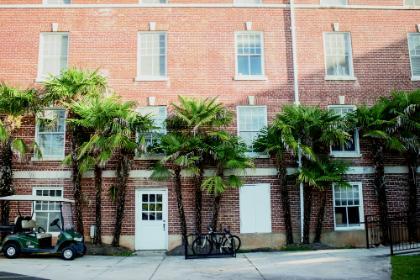
Palm trees are not native to this part of Virginia, but the eight wind mill palms that were planted behind Tabb Hall about 20 years ago are doing just fine despite the cold winters. The secret to their success? ‘They’re up against the brick wall and protected by buildings on both sides, the sun shines in on them from the south during the cold months, and there is a streamline directly underground. If you’re going to grow a palm tree this far north, these are the ideal conditions to do it,’ said Love, adding that the palms may have been planted by members of Alpha Sigma Alpha, a sorority founded at Longwood, whose insignia includes a palm tree.
What about protecting trees during construction projects?
Construction is one of the biggest challenges. That includes not just big projects, but also regular maintenance. We put up barricades and block trees off to protect them. Many people don’t realize that a tree’s roots come out as far as its canopy. We mulch under the trees to provide a natural barrier and keep equipment away from the trees and their roots.
I am also involved in new construction and landscaping conversations. Right now I’m working with the architects in charge of the upcoming Curry and Frazer renovation to protect the large pecan tree on the south end of Frazer. The tree is nearly as tall as the high rises and has a large root structure. We are working to ensure it stays protected, and we are planning to add 50-60 new trees as part of the new landscaping around the buildings.
So new construction provides opportunities to plant trees?
When there is construction, we always try to preserve or move existing trees, but sometimes we can’t. When we do remove a tree, we make sure to replace it. For example, we’ve added 17 trees between the new Register and Sharp residence halls. They are about 8-10 feet tall now. It will take 15 years for those trees to really get up in size, but they will be there for the incoming class of 2036 to enjoy.
Everyone can see that trees make the campus beautiful but does their contribution go deeper than that?
Studies have shown that a 10-year-old tree absorbs 48 pounds of CO2 per year, along with nitrogen dioxide, sulfur dioxide, carbon monoxide and carbon. Trees also provide students with quiet places to study, meditate and gather. Trees play an important part in our very survival on this planet and that trickles down to the quality of life on this campus.
About the Author
ILSA LOESER ’12
PHOTOS BY MERIDITH DE AVILA KHAN

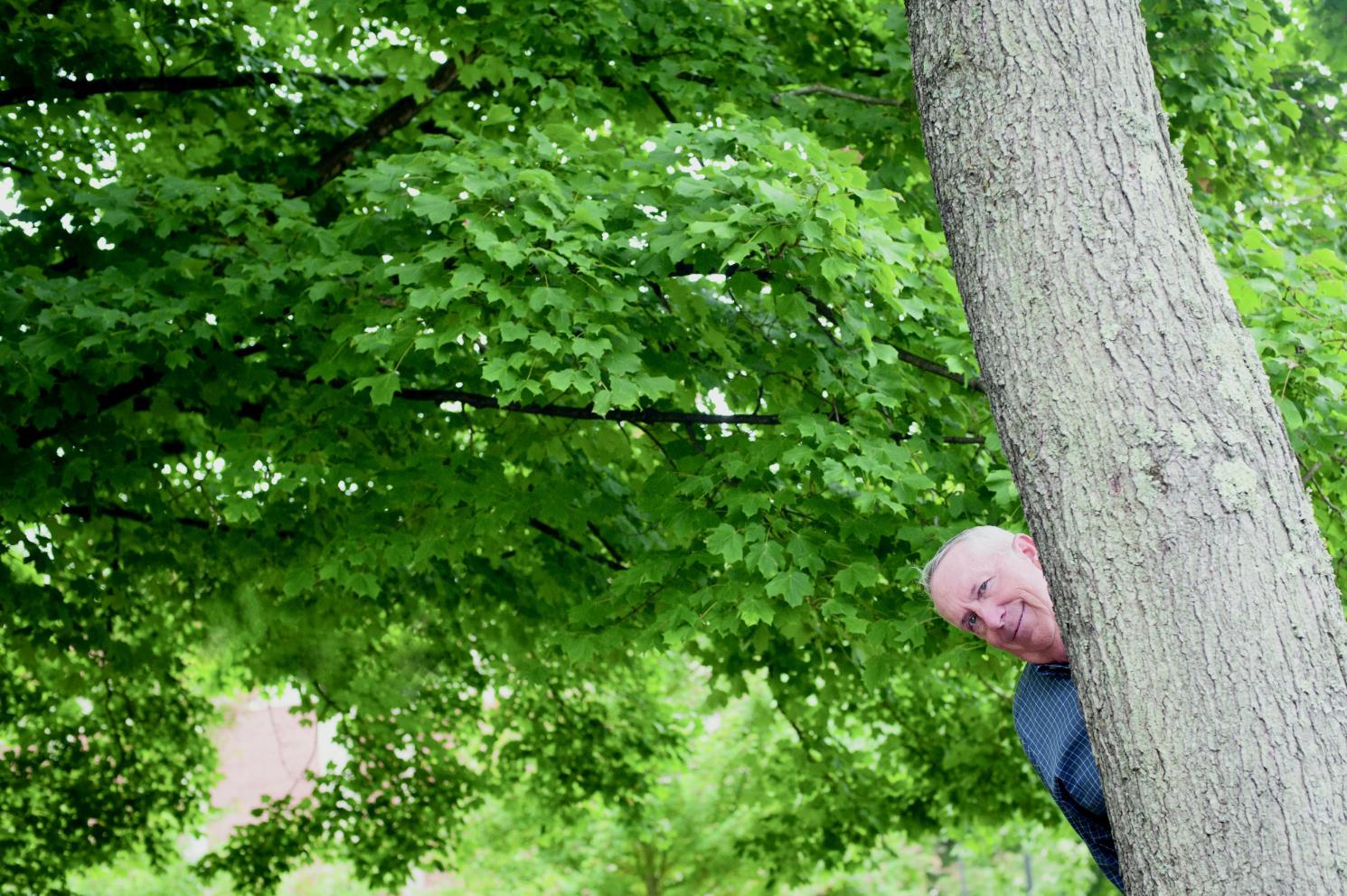
Leave a Comment